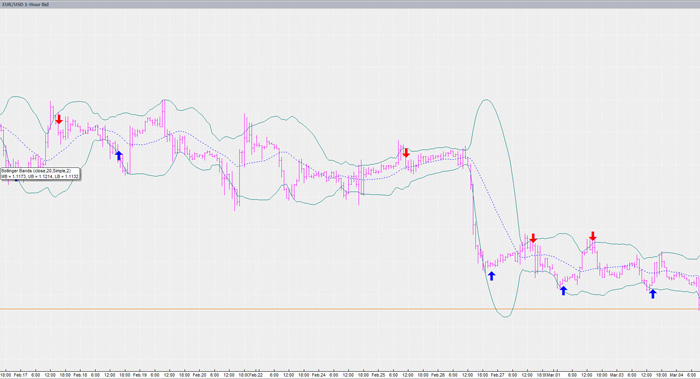In a previous blog I showed you a simple longer term forex trading system based upon moving averages and more precisely Bollinger Bands. This was a trend following method that aims to get you in on any big trending moves. But what happens if the market is chopping. Well you can still use Bollinger Bands but in a somewhat different manner – so called bounce trading.
We said previously that if plotting Bollinger Bands 2 standard deviations above and below the moving average we would expect price to remain within the bands 95% of the time. It therefor follows that in a choppy market if price breaks out above or below the bands there is a fair probability that price will fall back within the bands. Is there a trading system to be had here ?
Well a very common strategy is to wait for price to close above the upper Bollinger Band then wait for it to cross back below that upper band and close below it then enter short in anticipation of price continuing to move back towards the lower band. Vice versa for Long entries. Essentially we are buying bounces off the bottom band and selling bounces off the top band as illustrated below using EUR/USD 60 m charts with 20 period ma and 2 standard deviation Bollinger Bands ( a common set of rules in forex)

Now this strategy works great in a choppy market or when you are trading with the trend ie buying bounces off the lower band in a generally up trending market or selling bounces off the upper band in a generally down trending market. This is because the “weight” of the trend tends to exert itself and overpower the minor counter trend move that we have traded against.
The problem arises when we are selling bounces off the top band in a strong uptrend (or vice versa)…. ouch ….. the market can keep moving up for a long long time against our short position.
One obvious solution would of course be to use a stop loss to limit the the damage in such a situation.
Another solution would be to add some form of longer term trend filter so that we only buy the market when it is in a generally rising over the longer term and only sell the market when it is generally falling over the longer term. So in this system we might elect to only take buy trades when the 100 period moving average is above the 200 period moving average (ie a generally rising market when viewed in the longer term) and only take sell trades when the 100 period moving average is below the 200 period moving. See earlier blog on how to use moving averages.
Surprisingly this simple longer term trend filter works very well and keeps the trader out of some really bad trades.
So with trading systems you often find that you start with a very simple entry and exit rule (as above) that give relatively average or even poor results but shows some potential. By examination you then add a “filter” or two with the intention of eliminating some of the losing trades and hence improving overall trading system performance.
This is exactly what I do with my own computerised systems which generally comprise :
- simple entry and exit rules
- some sort of fixed money management stop and or trailing stop
- plus a filter or two to reduce the incidence of losing trades and hence greatly improve overall performance metrics.
So whilst there is a little more to designing trading systems than just using for instance a straight moving average cross over – it does not need to be much more to be a winning trading system !

